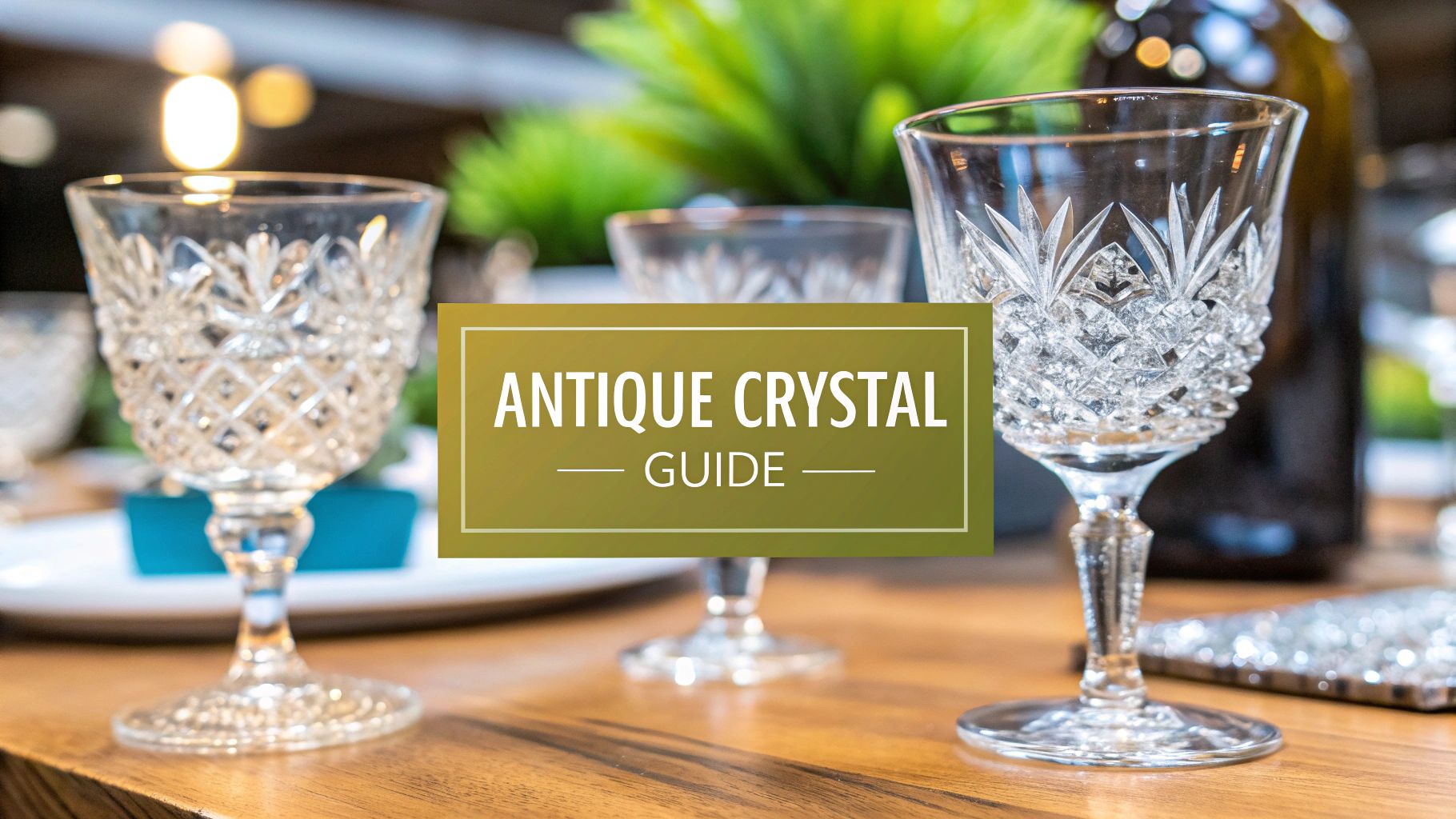There's a special kind of magic in antique crystal glasses. They’re not just old cups; they're little time capsules, each one carrying the story of the hands that made it and the tables it graced. Their brilliant sparkle and satisfying weight are marks of a bygone era of craftsmanship.
Holding one connects you to a rich history, from the legendary glass workshops of Europe to the stunningly intricate designs of America's Brilliant Period.
The Enduring Allure of Antique Crystal Glasses
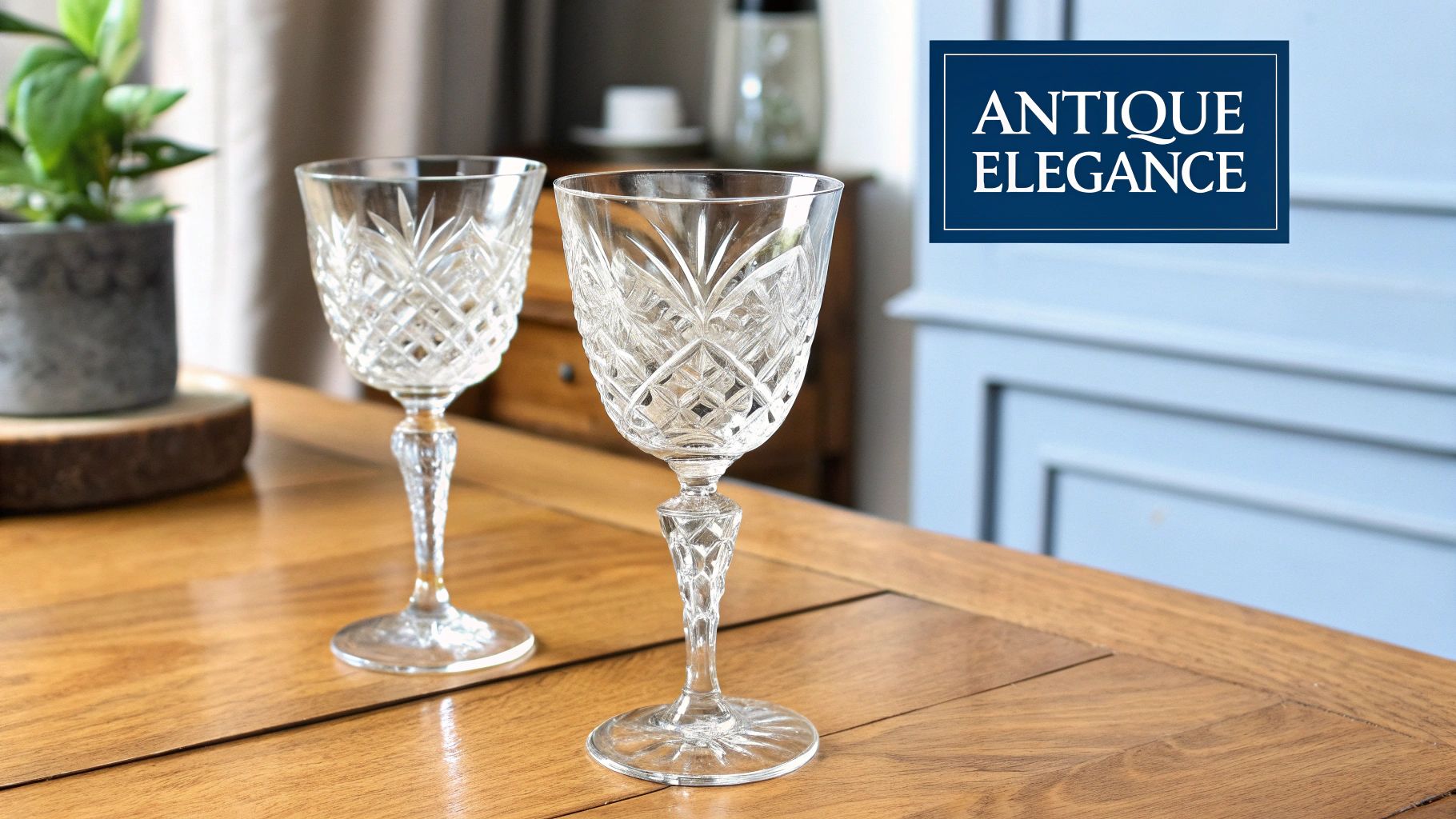
Have you ever held a piece of old crystal up to the light? It doesn't just reflect the light—it seems to drink it in and throw it back as a dazzling rainbow. That mesmerizing sparkle is one of the key reasons collectors are so drawn to these beautiful objects.
Unlike most modern glass, antique crystal was often made with lead oxide. This special ingredient is what gives it that unmatched clarity, a substantial feel in your hand, and that signature, bell-like ring when you gently tap the rim. It’s a multi-sensory experience.
Each glass feels like a story waiting to be told. The intricate cuts, the elegant curves—they all whisper of a specific time in history and a tradition of artistry passed down from master to apprentice. They're more than just vessels for a drink; they're miniature sculptures that speak of innovation and social history.
What This Guide Will Uncover
I’ve designed this guide to be your go-to companion as you dive into the fascinating world of antique crystal. My goal is to help you move beyond simple admiration and develop the confident eye of an expert. We'll cover everything you need to know to build, understand, and care for a collection you can be truly proud of.
Here’s a look at what we’ll explore together:
- The Origins of Crystal: We’ll travel back in time to discover how crystal glassware was invented and see how iconic production centers came to be.
- Identification and Patterns: You'll learn how to spot the work of legendary makers like Waterford and Baccarat by recognizing their unique marks and signature patterns.
- Valuation Essentials: I'll show you what to look for when determining a piece's value, from its age and condition to its rarity and maker.
- Proper Care and Display: We'll cover the best ways to clean, store, and show off your collection so it remains beautiful for generations to come.
By the end of our journey, you'll be able to spot a true treasure, understand its story, and know exactly how to care for it.
The love for this material has certainly stood the test of time. While we're focusing on historical pieces, the timeless charm of crystal is still celebrated in things like modern clear crystal cups today.
So, whether you're just starting your collection, have inherited a few family heirlooms, or simply appreciate things of timeless beauty, this guide will give you the knowledge you need to deepen your passion.
A Little Trip Through the History of Crystal
To really get why antique crystal is so special, you have to understand where it came from. Its story doesn't start in ancient times. Instead, it begins with a scientific breakthrough in the 17th century that completely upended the world of fine dining and home decor. Before then, glass was just functional—often cloudy, full of bubbles, and far from perfect.
Glassmakers all over Europe were in a race to create a clearer, more brilliant material. They wanted something that could compete with the stunning natural rock crystal being imported from places like Venice. The dream was to make glass with incredible clarity that could also be cut with deep, intricate designs without shattering.
This hunt for perfection eventually led to a game-changing moment in England. A simple tweak to the recipe was about to give birth to the material we now know and love as crystal.
The Lightbulb Moment
The invention of what we now call lead crystal can be pinned on one man: George Ravenscroft. Around 1674, this English glassmaker started experimenting by adding lead oxide to his glass formula. He was actually just trying to stop "crizzling," a frustrating network of tiny cracks that ruined earlier types of glass. What he got, however, was something truly spectacular.
This new "lead glass" was heavier and softer, but most importantly, it had a much higher refractive index. In plain English, that means it bent light in a way that created a dazzling, fiery sparkle no one had ever seen before in man-made glass. Not only was it beautiful, but it was also easier to work with, allowing artisans to carve in the elaborate designs that were becoming fashionable.
It was this single innovation that gave birth to crystal glassware. Ravenscroft’s discovery created the blueprint for an entire industry that would sweep across Europe, with each region putting its own unique artistic spin on the craft.
The entire history of antique crystal is built on this English discovery. Ravenscroft’s lead glass became the new benchmark for quality, setting the stage for centuries of incredible artistry. You can learn more about the history of antique crystal glassware to see just how big of an impact it made.
Europe's Crystal Hotspots
After England's big discovery, the art of making crystal took off across the continent. A few key regions became powerhouses, and their names still mean quality to this day.
- Bohemia (now the Czech Republic): Bohemian artisans were absolute masters of engraving and cutting. Their work is known for its incredibly detailed, deeply cut patterns and stunning clarity. Finding a true piece of antique Bohemian crystal is a real treat for any collector.
- Waterford (Ireland): Founded way back in 1783, Waterford quickly became a legend, producing some of the finest crystal on the planet. Their signature deep wedge cuts, like the world-famous Lismore pattern, give their pieces a satisfying heft and an unmatched sparkle.
- Baccarat (France): Over in the Lorraine region of France, Baccarat became synonymous with elegance and sophistication. The company made breathtaking stemware, chandeliers, and decor for kings, queens, and the ultra-wealthy, cementing its reputation as a top-tier luxury brand.
These centers of excellence really set the bar. Their historic pieces are among the most valuable and sought-after antique crystal glasses you can find.
America's Brilliant Period
While Europe led the way for centuries, the United States had its own golden age of crystal. We call it the American Brilliant Period. From about 1876 to 1917, American glass companies went all-in, creating some of the most elaborate and richly decorated cut glass the world has ever seen.
This was the absolute peak of ornate design. You can spot glass from this era by its incredibly complex patterns, which often featured geometric motifs like stars, hobnails, and fans cut deeply into every available surface. The sheer density of the cutting created an unbelievable sparkle that perfectly captured the "more is more" attitude of the Gilded Age.
Knowing this history is what gives each piece its soul. When you pick up an antique crystal glass, you’re not just holding a fancy cup. You’re holding a piece of history—a sliver of Bohemian artistry, a testament to Waterford's legacy, or a glittering symbol of American ambition.
How to Identify Makers and Iconic Patterns
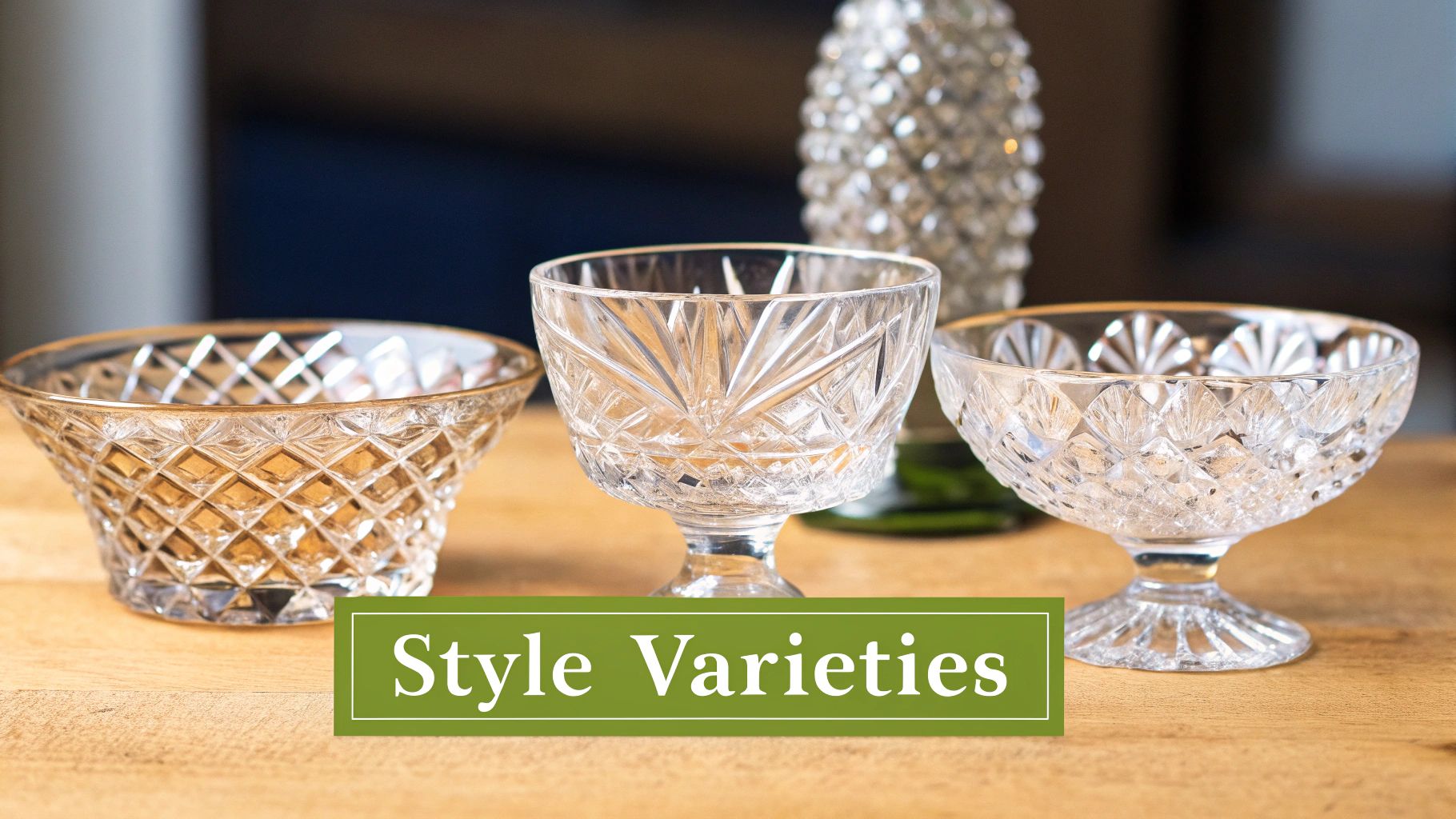
Diving into the world of antique crystal can feel a bit like being a detective. Every glass holds clues to its past, just waiting for someone to piece together its story. Figuring out who made a piece and when is the real key to unlocking its history and, of course, its value.
The great news is, you don't need a magnifying glass and a deerstalker hat to get started. Once you learn to spot a few key identifiers—from faint maker's marks to the signature "handwriting" of a specific pattern—you can start telling a treasured heirloom from a common reproduction with confidence.
It all comes down to careful observation. It’s about looking closely at the base, feeling the weight and sharpness of the cuts, and getting to know the distinct artistic flair that defined the legendary crystal houses.
The Search for a Signature
The most concrete clue you can find on a piece of crystal is the maker's mark. It’s the artist's signature, plain and simple. These marks confirm the manufacturer and often help you pinpoint a date, but finding them can sometimes be a challenge.
Over the centuries, makers have used a few different methods to sign their work. Knowing what you're looking for is the first step in your investigation.
- Acid-Etched Marks: This is the most common method you'll encounter. It appears as a faint, frosted logo or name, almost always on the underside of the base. The trick to seeing it is to hold the glass up to a good light source and tilt it back and forth until the mark catches the light just right.
- Engraved Signatures: Some of the most prestigious makers, like Lalique, would hand-engrave their name. These signatures are often incredibly fine and might be tucked away near the edge of the base.
- Paper Labels: Finding an original paper or foil label intact is a rare treat. They are incredibly fragile and often degrade over time, so if you find a piece with a label, handle it with extreme care.
A maker’s mark is your most reliable piece of evidence. For example, Baccarat began using a single, discreet acid-etched mark of a circle containing a decanter, a goblet, and a tumbler around 1936. Finding this mark is a clear indicator of a piece's authenticity and production era.
These marks are often tiny and can be worn down from decades of use, so patience and a bright light are your best friends here. To really get your eye in, exploring a visual database of antique glass makers' marks can be an enormous help.
Recognizing Iconic Patterns
But what if there's no mark? Don't panic—many older pieces were never marked at all. When that happens, your focus simply shifts from the signature to the "handwriting" of the design itself. The most iconic patterns are often as recognizable as any logo.
Think of it this way: just as you can identify a painter by their brushstrokes, you can learn to identify a crystal maker by their signature cuts.
Let’s look at a few of the heavy hitters you're likely to come across:
- Waterford's Lismore: Introduced in 1952, this is arguably the most famous crystal pattern in the world. It’s defined by a timeless combination of elegant diamond cuts and clean, upright wedge cuts.
- Baccarat's Harcourt: This pattern is architectural and powerful. Created way back in 1841, its defining feature is the set of six flat, hexagonal cuts on the bowl that rise from a sturdy, faceted stem—a design originally commissioned for French royalty.
- Fostoria's American: A much-loved American pattern, famous for its distinct cubist-inspired design. The chunky, blocky, prismatic shapes were relatively easy to produce, which made it incredibly popular and accessible right from its introduction in 1915.
Learning to spot these patterns just takes a bit of practice. Start by looking at pictures in collector's guides and online archives. Before you know it, you'll start to develop a feel for the unique style of each major house, turning your treasure hunts at flea markets and estate sales into truly exciting discoveries.
How Much Are My Antique Crystal Glasses Worth?
Figuring out what your antique crystal is worth is about more than just appreciating its sparkle. It’s a bit like being a detective, piecing together clues about its history, maker, and craftsmanship to arrive at a real-world value. Just like a classic car expert looks beyond a shiny paint job to inspect the engine and original parts, a crystal collector learns to spot the subtle details that separate a run-of-the-mill piece from a genuine treasure.
Whether you're thinking of selling, insuring a collection, or just want to know more about a family heirloom, understanding these factors is key. It all really boils down to four main things: who made it, how rare it is, the quality of the work, and its current condition. Each piece of the puzzle is important, and a flaw in one area can definitely affect the final price tag.
Maker and Rarity
First things first: the maker's mark can make all the difference. A piece from a legendary brand like Baccarat, Waterford, or Lalique will almost always fetch a higher price than a similar but unmarked glass. These names are famous for a reason—they represent a history of exceptional quality and artistry that collectors are happy to pay for.
Age and rarity go hand-in-hand. While an older piece isn't automatically more valuable, a rare pattern from a limited production run is a huge find. Think about it: a complete set of glasses in a pattern that was only made for a few years in the 19th century is a much bigger deal than a single glass from a popular 20th-century line that was produced by the thousands.
Craftsmanship and Design
The sheer artistry of a piece is a major clue to its value. Hand-blown and hand-cut crystal is where the real money is, thanks to its one-of-a-kind character. A quick trick? Check for seams. Machine-made glass often has faint vertical lines where the mold came together. True hand-finished antique crystal, on the other hand, will be perfectly seamless.
The complexity of the pattern matters, too. Intricate, deep cuts that took a master artisan hours to create are far more valuable than simple, lightly etched designs. Hold the glass up to a window or lamp—the more facets it has, the more it will dance and sparkle. That brilliant fire is a tell-tale sign of top-tier craftsmanship.
Assessing Condition
Condition is the ultimate deal-breaker. A piece in mint condition will always be worth significantly more than one with obvious damage. You have to put on your inspector's hat and carefully check for any little flaw that could bring down its value.
Here’s what to look out for:
- Chips and Cracks: Gently run your fingertip along the rim and the base. These spots are notorious for tiny nicks you might otherwise miss. Even a minuscule chip can slash a glass's value by 50% or more.
- Scratches: Use a bright light and tilt the glass back and forth. This will reveal any surface scratches from decades of use and cleaning.
- Cloudiness: A foggy, dull appearance is a bad sign. Often called "sick glass," this is usually caused by mineral buildup or, even worse, permanent damage from a dishwasher. This can be very difficult to fix and will tank the value.
To get a clearer picture of how these elements work together, here’s a quick summary of what to look for when you're sizing up a piece of antique crystal.
Key Factors Influencing Crystal Glass Value
| Valuation Factor | High-Value Indicators | Low-Value Indicators |
|---|---|---|
| Maker's Mark | Signed by a famous house (Baccarat, Lalique, Waterford). | Unmarked, or from a lesser-known manufacturer. |
| Rarity | Discontinued pattern, limited production run, complete set. | Common pattern, mass-produced for many years. |
| Craftsmanship | Seamless, hand-blown body with deep, intricate hand-cuts. | Visible mold seams, simple or lightly etched patterns. |
| Clarity & Brilliance | Exceptional sparkle and rainbow refraction in light. | Dull, cloudy, or "sick glass" appearance. |
| Condition | Pristine, with no chips, cracks, or scratches. | Any chips, cracks, deep scratches, or repairs. |
| Weight & Material | Heavy for its size, clear ringing sound when tapped. | Lightweight, dull thud when tapped. |
Ultimately, getting a feel for valuing antique crystal is a skill that grows with experience. The more you handle and research, the more confident you'll become.
For a broader look at how experts assign value to historical items, our price guide to antiques is a great place to start. By combining knowledge of the great makers with a sharp eye for quality and condition, you’ll be well on your way to discovering the true worth of your sparkling treasures.
Caring For and Displaying Your Collection
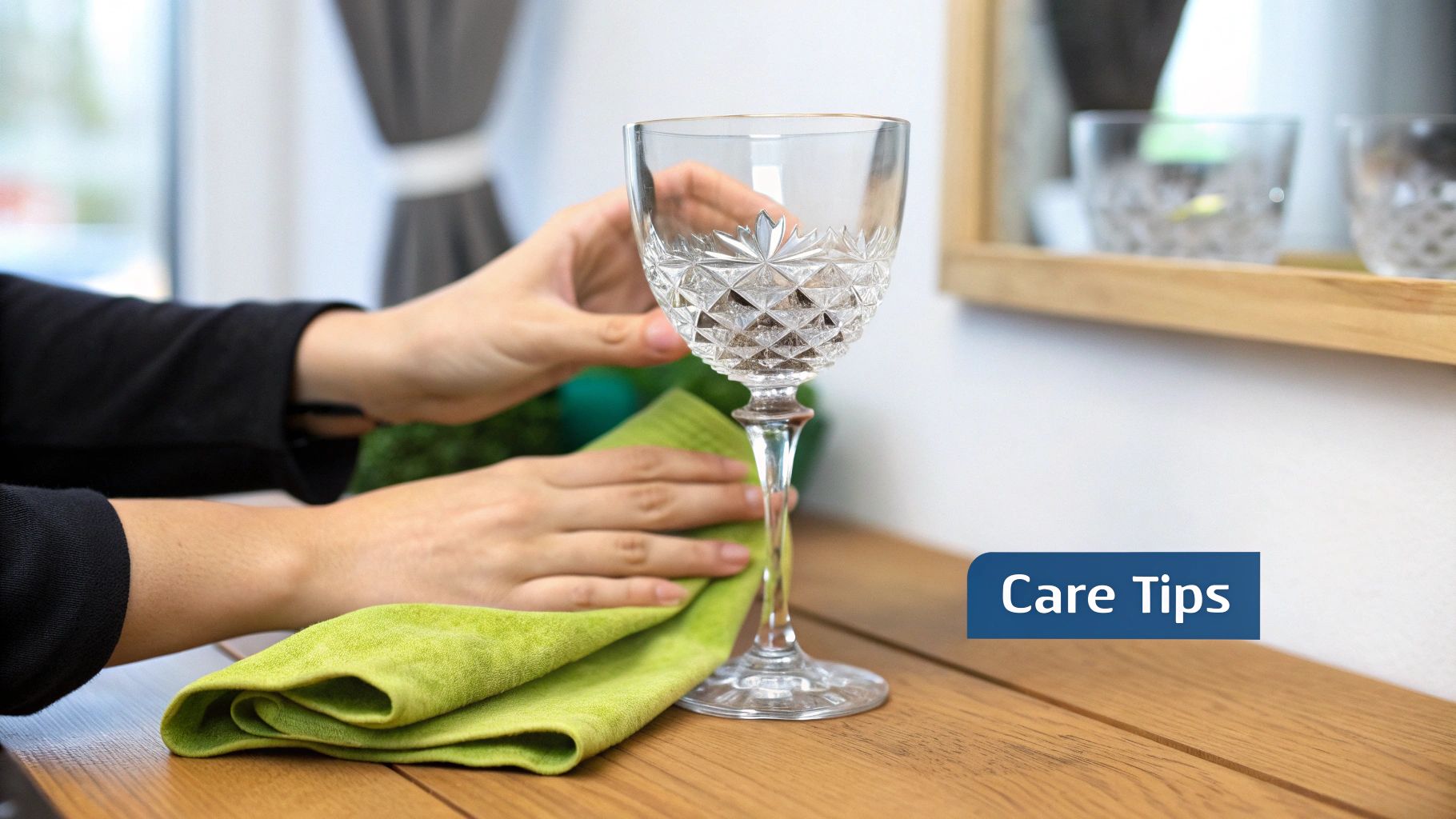
Finding that perfect set of antique crystal glasses is a real thrill, but that’s just the beginning of the story. Keeping them brilliant for years—and maybe even for the next generation—is all about proper care and display. These stunning pieces come from an era long before dishwashers and potent detergents, and a bit of modern carelessness can sadly cause permanent harm.
If you remember only one thing, make it this: never put it in the dishwasher. The combination of high heat and harsh detergents will permanently etch the surface. This damage creates a cloudy, "sick" look that completely robs the crystal of its clarity and value. Lead crystal is particularly soft, making it especially vulnerable.
Proper care is a gentle, hands-on affair, but it’s one that protects the soul of each piece.
The Gentle Art of Hand-Washing Crystal
Don't let the thought of washing your crystal intimidate you. It’s less of a chore and more of a careful ritual. A few simple steps are all it takes to keep your glasses sparkling and safe.
- Prep Your Sink: Before you start, line the bottom of your sink with a soft dish towel or a rubber mat. This little bit of cushioning is a lifesaver if a slippery glass takes a tumble.
- Get the Temperature Just Right: Use two plastic tubs (one for washing, one for rinsing) and fill them with lukewarm water. Sudden, extreme temperature changes can cause thermal shock and crack the glass.
- Choose a Mild Soap: A tiny drop of a gentle, ammonia-free dish soap is all you need. Harsh chemicals are the sworn enemy of antique crystal.
- One Glass at a Time: Using a soft cloth or sponge, gently wash each piece by itself. Steer clear of any abrasive scrubbers that could scratch the delicate surface.
- Rinse and Dry Immediately: Dip the glass in the rinse tub, then immediately dry it with a lint-free microfiber cloth. This prevents those pesky water spots from forming.
For pieces like decanters that can be tricky to get spotless, this handy guide to cleaning crystal decanters for a sparkling finish is a fantastic resource.
The real secret is to minimize handling and risk. Washing one glass at a time and having a soft landing pad in your sink are the two best things you can do to avoid chips and cracks.
Smart Storage and Dazzling Displays
Once your crystal is gleaming, how you store it is just as important. The right approach prevents dust, reduces the risk of damage, and keeps your collection looking its best.
When putting your glasses away, always store them rim-side up. Resting a glass on its rim, its most fragile part, puts unnecessary stress on it and makes chipping far more likely. It’s also a good idea to leave a little space between each piece so they aren’t clinking against each other.
A closed glass cabinet is the ideal way to show off your collection. It keeps the dust off and protects from accidental bumps while letting you admire the beauty.
- Light Them Up: Soft, indirect lighting really brings out the sparkle in the crystal's facets. LED puck lights or strips inside a cabinet work wonders and don't produce enough heat to cause damage.
- Arrange with Style: Group your glasses by height, pattern, or even color to create a more dynamic look. Avoid overcrowding the shelves—giving each piece a bit of breathing room helps its unique design stand out.
If you're looking for more great ways to showcase your treasures, check out our guide filled with creative collectible display ideas.
The Modern Collector's Market for Antique Crystal
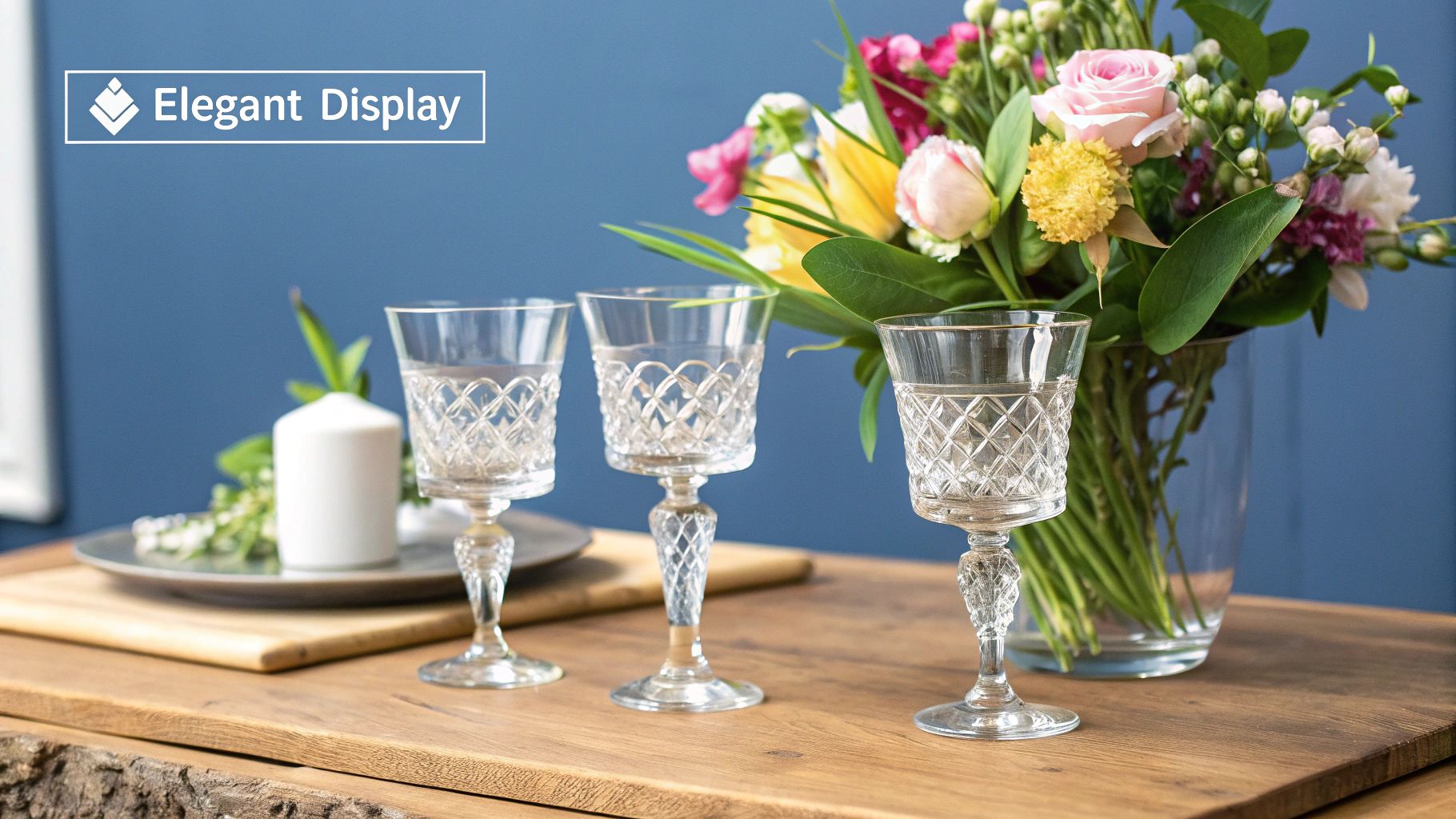
In a world filled with mass-produced everything, it's no surprise that people are drawn to the charm and story of antique crystal. These glasses aren't just surviving; they're enjoying a real resurgence. A new wave of collectors values the incredible craftsmanship and sustainable nature of these pieces far more than fleeting, factory-made trends.
It all comes down to a desire for authenticity. Let's be honest, a hand-cut goblet from the American Brilliant Period just has more soul than something off a modern assembly line. This appreciation for genuine character has kept demand for high-quality antique crystal glasses strong, making them a smart choice for both seasoned pros and anyone just starting their collection.
The numbers back this up, too. The U.S. crystal glass market recently hit sales of around $42.33 million, and it's on track to approach $50 million. Big names like Baccarat and Lalique still fetch premium prices, with a single glass starting around £80 and full sets often selling for over £500. It’s a clear sign of their lasting value, and you can explore how top brands influence the market to see why these valuations hold up.
Current Trends and Collector Insights
Today's collectors are all about mixing the old with the new. Gone are the days of keeping the "good crystal" locked away for a special occasion that never seems to arrive. People are weaving these beautiful glasses right into their everyday lives.
- Mix-and-Match Aesthetics: Forget perfectly matched sets. The real fun is in curating a collection of different patterns and eras. It creates a personalized table setting that tells a story.
- Sustainable Luxury: Choosing antique crystal is a vote for sustainability. You're giving a gorgeous, well-made item a second life, which cuts down on waste and champions quality that lasts.
- The Rise of the Bar Cart: Home bartending is back in a big way, and with it comes the hunt for unique glassware. Vintage cocktail coupes, tumblers, and highball glasses are in high demand for adding a dash of old-school glamour to a modern bar setup.
Collecting antique crystal is about more than just owning beautiful things. It's about becoming a guardian of history—preserving the artistry and stories etched into each piece for the next generation.
Your Journey as a Collector
We've covered a lot of ground, from the very beginnings of lead crystal to the nitty-gritty of identifying and valuing what you find. You now have the tools to spot a maker's mark, recognize a classic pattern, and judge a piece's condition with a more confident eye. Remember, every little detail—from a tiny chip to a faint signature—is a breadcrumb leading back to its past.
With this knowledge in hand, you’re ready to explore antique shops, estate sales, and online markets. Every piece of crystal you come across is a little monument to timeless style and incredible skill. Whether you build a sprawling collection or just cherish a single family heirloom, you're keeping a small piece of sparkling history alive.
Got Questions About Antique Crystal? We've Got Answers.
Even after you've learned the basics, the world of antique crystal can leave you with a few nagging questions. That's perfectly normal. Below, I’ve put together some quick, straightforward answers to the things collectors ask me most often. Think of this as your go-to guide for those final points of confusion.
Getting these practical details sorted will give you a lot more confidence, whether you're out hunting for a new piece or just trying to figure out how to best enjoy what you already have. Let's dive in.
Is It Safe to Drink From Old Lead Crystal?
This is easily one of the most common—and most important—questions people have. The short answer is yes, for occasional use, it's generally considered safe. The real issue isn't drinking from the glass, but storing liquids in it.
You'll want to avoid leaving acidic drinks like wine, whiskey, or orange juice in a lead crystal decanter or glass for long periods. While a tiny amount of lead can leach into the liquid, studies show the amount from a single-use serving is incredibly small. So, use your antique crystal glasses for the toast, not as a permanent home for your port.
The expert consensus is pretty clear: short-term, occasional use isn't a significant risk. The concern is prolonged contact, especially with acidic drinks. So go ahead and enjoy that special glass of champagne—just be sure to wash the flute afterward.
What’s the Real Difference Between Crystal and Glass?
At its core, the difference is all about what's inside. True crystal is a type of glass that has minerals—usually lead oxide—added to it. This special ingredient gives it qualities you just don't find in your everyday soda-lime glass. A good way to think of it is that all crystal is glass, but not all glass is crystal.
Here’s how you can tell them apart:
- Weight: Pick one up. Crystal feels surprisingly heavy for its size compared to a regular glass object.
- Clarity: That mineral content gives crystal a stunning brilliance and sparkle. It just looks clearer and more refractive than standard glass.
- Sound: This is the classic test. Gently tap the rim with your fingernail. Crystal will sing with a clear, resonant "ping" that lasts for a moment. Glass just makes a dull thud.
- Softness: The addition of lead makes crystal softer, which is what allows artisans to carve those incredibly sharp and detailed facets into it without it cracking.
How Do I Know If My Crystal Is a Fake?
Spotting a genuine antique from a modern imitation or a simple piece of glass comes down to using your senses. Don't just look for a maker's mark—many fakes have them.
First, do the "ping" test. A beautiful, musical ring is a fantastic sign. Next, feel its heft; it should feel substantial in your hand.
Then, get up close and personal with the cuts. Hand-cut antique crystal has incredibly sharp, clean facets. If the edges feel rounded, smooth, or dull, you're likely looking at pressed glass that was popped out of a mold. Finally, hold it up to a light source. Real crystal acts like a prism, scattering light into a dazzling rainbow of colors. Most fakes just can't do that.
Have a piece of crystal you're curious about? The Curio app can help you uncover its history, origin, and potential value with just a photo. Download Curio today and let your antiques tell their story.
